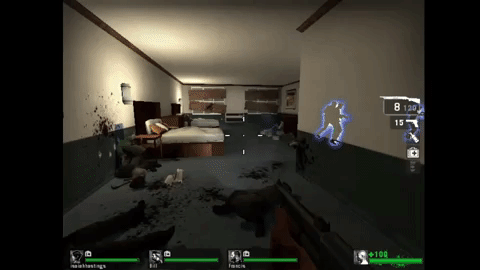"Last Resort 1" - Left 4 Dead
"LAST RESORT 1" is the first of a four-map Left 4 Dead campaign, each of which was completed by one team member. In this opening level, the survivors begin their race to rescue by winding through both hotel rooms and a conference event space long since overrun by Infected.
LEVEL INFORMATION
Role: Level Designer
Game: Left 4 Dead
Date: August-December 2020
Team Size: 4
Genre: FPS, Multiplayer
Engine: Source SDK
DOWNLOADS
Responsibilities
TEAM MEMBER
-
Communicated intended design to team members and stakeholder through written documentation
-
Helped organize regular team playtests to ensure all levels integrated smoothly and fit together
-
Took notes on playtest videos, then turned notes into actionable items for iteration
LEVEL DESIGN
-
Built a level matching Left 4 Dead's campaign style
-
Blocked out the level using BSP tools to test gameplay, then refined and added aesthetics
-
Coordinated with team members at all stages, including regarding any design changes during development
-
Optimized level for rapid compile times
Click each image for details and a larger view.
"LAST RESORT 1" - GALLERY


DESIGN HIGHLIGHTS
Combat Pacing
In Left 4 Dead, an AI director controls enemy spawning. The absence of hand-placed enemies means level layouts double as combat design. This gave me two main tools:
-
Long sight lines and few entrances limited enemy spawning, creating quieter spaces.
-
Blocked sight-lines with many entrances led to larger spawns and higher-intensity areas.
Alternating these types of spaces allowed me to create peaks and valleys of combat intensity throughout the level.
EXAMPLE: This gif shows a U-shaped space created by linked hotel rooms. The corners and blocked sightlines provided an excellent opportunity for enemies to spawn here and attack.

Designing with the AI director's behavior in mind let me pace the level's combat despite not placing enemies by hand.
Aesthetic Design

The level's aesthetic design required distilling complex hotel decor into iconic visuals to make the space:
-
Recognizable, helping players orient themselves as they start a new campaign in the hotel.
-
Distinct from other high-rise urban buildings explored in other Left 4 Dead levels.
-
Convincing enough to remain believable despite other "unrealistic" aspects of the spaces (ex. increased room size, furniture pushed to walls) necessary for combat.
EXAMPLE: In the room shown here, iconic aesthetic elements include the crown molding, the headboard, the wall-mounted sconces, and the air conditioning unit on the window.
Players being able to instantly grasp the hotel setting was essential to putting my teammates' later levels in context.
Team Collaboration
Though each team member built their own level, from paper maps to final product, teamwork and coordination were essential to the development of "Last Resort". I contributed to:
-
Brainstorming level themes and responsibilities.
-
Negotiating through-lines for the campaign, such as my proposal of blue walls/carpeting in all levels to keep aesthetics consistent across maps.
-
Regular meetings in which the team built and played through the campaign as a whole to test its flow and pacing.
EXAMPLE: The team brainstormed first on Miro, allowing us to gather inspiration for maps, visuals, and to mock-up a map design that got everyone on board from day 1 of development.
Using a tool like Miro allowed my team and I to quickly put ideas together and iterate on our concept maps.
POSTMORTEM
What Went Well
-
Team buy-in and participation. We figured out quickly what our concept would be – a large, luxury hotel – and from there, each person was able to take their section and make it their own, building off our shared understanding of our design goals and our core theme.
-
Check-ins prevent problems and build team accountability. The team met once a week throughout development to build our maps together and play them. This allowed us to give feedback on each other’s work, and helped ensure everyone met milestones on time.
What Was Learned
-
Time spent on coordination early in production pays off down the line. While my team was quite successful in our communication, some things slipped through the cracks. Greater clarity in pre-production would have allowed us to avoid redoing work to make maps match.
-
Level styles can diverge during collaboration. Despite our coordination, personal design styles became visible during later aesthetic milestones. Given more time and even more collaboration, we could have made our level transitions even more seamless.








